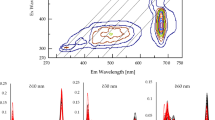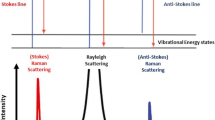Abstract
Because of its high price, extra virgin olive oil is frequently targeted for adulteration with lower quality oils. This paper presents an innovative optical technique capable of quantifying and discriminating the adulteration of extra virgin olive oil caused by lower-grade olive oils. An original set-up for diffuse-light absorption spectroscopy in the wide 400–1,700 nm spectral range was experimented. It made use of an integrating sphere containing the oil sample and of optical fibers for illumination and detection; it provided intrinsically scattering-free absorption spectroscopy measurements. This set-up was used to collect spectroscopic fingerprints of authentic extra virgin olive oils from the Italian Tuscany region, adulterated by different concentrations of olive-pomace oil, refined olive oil, deodorized olive oil, and refined olive-pomace oil. Then, a straightforward multivariate processing of spectroscopic data based on principal component analysis and linear discriminant analysis was applied which was successfully capable of predicting the fraction of adulterant in the mixture, and of discriminating its type. The results achieved by means of optical spectroscopy were compared with the analysis of fatty acids, which was carried out by standard gas chromatography.





Similar content being viewed by others
References
Willett WC (1998) Nutritional epidemiology, 2nd ed., vol. 30 of Monographs in Epidemiology and Biostatistics. Oxford University Press, New York
Paiva-Martins F, Fernandes J, Rocha S, Nascimento H, Vitorino R, Amado F, Borges F, Belo L, Santos-Silva A (2009) Effects of olive oil polyphenols on erythrocyte oxidative damage. Mol Nutr Food Res 53(5):609–616
Gimeno E, Fitò M, Lamuela-Raventòs RM, Castellote AI, Covas M, Farré M, de La Torre-Boronat MC, Lòpez-Sabater MC (2002) Effect of ingestion of virgin olive oil on human low-density lipoprotein composition. Eur J Clin Nutr 56:114–120
Covas MI (2007) Olive oil and the cardiovascular system. Pharmacol Res 55:175–186
Commission Regulation EEC n. 2568/91 and subsequent amendements, online: http://eur-lex.europa.eu/LexUriServ/site/en/consleg/1991/R/01991R2568-20031101-en.pdf.
Fasciotti M, Pereira Netto AD (2010) Optimization and application of methods of triacylglycerol evaluation for characterization of olive oil adulteration by soybean oil with HPLC-APCI-MS-MS. Talanta 81:1116–1125
Agiomyrgianaki A, Petrakis PV, Dais P (2010) Detection of refined oil adulteration with refined hazelnut oil by employing NMR spectroscopy and multivariate statistical analysis. Talanta 80:2165–2171
Priego Capote F, Ruiz Jiménez J, Luque de Castro MD (2007) Sequential (step-by-step) detection, identification and quantitation of extra virgin olive oil adulteration by chemometric treatment of chromatographic profiles. Anal Bioanal Chem 388:1859–1865
Jafari M, Kadivar M, Keramat J (2009) Detection of adulteration of Iranian olive oil using instrumental (GC, NMR, DSC) methods. Journal of the American Oil Chemist Society 86:103–110
Angiuli M, Bussolino GC, Ferrari C, Matteoli E, Righetti MC, Salvetti G, Tombari E (2009) Calorimetry for fast authentication of edible oils. Int J Thermophys 30:1014–1024
Chiavaro E, Vittadini E, Rodriguez-Estrada MT, Cerretani L, Bendini A (2008) Differential scanning calorimeter application to the detection of refined hazelnut oil in extra virgin olive oil. Food Chem 110:248–256
Ferrari C, Angiuli M, Tombari E, Righetti MC, Matteoli E, Salvetti G (2007) Promoting calorimetry for olive oil authentication. Thermochim Acta 459:58–63
Lizhi H, Toyoda K, Ihara I (2010) Discrimination of olive oil adulterated with vegetable oil using dielectric spectroscopy. J Food Eng 96:167–171
Marina AM, Che Man YB, Amin I (2010) Use of the SAW sensor electronic nose for detecting the adulteration of virgin coconut oil with RDB palm kernel olein. Journal of the American Oil Chemistry Society 87:263–270
Hai Z, Wang J (2006) Electronic nose and data analysis for detection of maize oil adulteration in sesame oil. Sensors and Actuators B 119:449–455
Lerma-Garcìa MJ, Ramis-Ramos G, Herrero-Martìnez JM, Simò-Alfonso EF (2010) Authentication of extra virgin olive oils by Fourier-transform infrared spectroscopy. Food Chem 118:78–83
Vlachos N, Skopelitis Y, Psaroudaki M, Konstantinidou V, Chatzilazarou A, Tegou E (2006) Applications of Fourier transform-infrared spectroscopy to edible oils. Anal Chim Acta 573–574:459–465
Gurdeniz G, Ozen B (2009) Detection of adulteration of extra-virgin olive oil by chemometric analysis of mid-infrared spectral data. Food Chem 116:519–525
Ozdemir D, Ozturk B (2007) Near infrared spectroscopic determination of olive oil adulteration with sunflower and corn oil. Journal of Food and Drug Analysis 15(1):40–47
Poulli KI, Mousdis GA, Georgiou CA (2007) Rapid synchronous fluorescence method for virgin olive oil adulteration assessment. Food Chem 105:369–375
Guimet F, Ferré J, Boqué R (2005) Rapid detection of olive-pomace oil adulteration in extra virgin olive oils from the protected denomination of origin Siurana using excitation-emission fluorescence spectroscopy and three-way methods of analysis. Anal Chim Acta 544:143–152
Christy AA, Kasemsumran S, Du Y, Ozaki Y (2004) The detection and quantification of adulteration in olive oil by near-infrared spectroscopy and chemometrics. Anal Sci 20:935–940
Sayago A, Morales MT, Aparicio R (2004) Detection of hazelnut oil in virgin olive oil by a spectrofluorimetric method. Eur Food Res Technol 216:480–483
Downey G, McIntyre P, Davies AN (2002) Detecting and quantifying sunflower oil adulteration in extra virgin olive oils from the Eastern Mediterranean by visible and near-infrared spectroscopy. J Agric Food Chem 50:5520–5525
Maggio RM, Cerretani L, Chiavaro E, Kaufman TS, Bendini A (2010) A novel chemometric strategy for the estimation of extra virgin olive oil adulteration with edible oils. Food Control 21:890–895
Bucci R, Magrì AD, Magrì AL, Marini D, Marini F (2002) Chemical authentication of extra virgin olive oil varieties by supervised chemometric procedures. J Agric Food Chem 50:413–418
Galtier O, Dupuy N, Le Dréau Y, Olliver D, Pinatel C, Kister J, Artaud J (2007) Geographic origins and compositions of virgin olive oils determinated by chemometric analysis of NIR spectra. Anal Chim Acta 595:136–144
Guimet F, Ferré J, Boqué R, Rius FX (2004) Application of unfold principal component analysis and parallel factor analysis to the exploratory analysis of olive oils by means of excitation–emission matrix fluorescence spectroscopy. Anal Chim Acta 515:75–85
Torrecilla JS, Rojo E, Dominguez JC, Rodrìguez F (2010) A novel method to quantify the adulteration of extra virgin olive oil with low-grade olive oils by UV–VIS. J Agric Food Chem 58:1679–1684
Mellon MG (1950) Analytical absorption spectroscopy. Wiley, New York
Bauman RP (1962) Absorption spectroscopy. Wiley, New York
Mark H, Workman J Jr (2003) Statistics in spectroscopy, 2nd edn. Academic, San Diego
Fecht I, Johnson M (1999) Non-contact scattering independent water absorption measurement using a falling stream and integrating sphere. Meas Sci Technol 10:612–618
Merzlyak MN, Razi Naqvi K (2000) On recording the true absorption spectrum and the scattering spectrum of a turbid sample: application to cell suspensions of the cyanobacterium Anabaena variabilis. J Photochem Photobiol, B 58:123–129
Jàvorfi T, Erostyàk J, Gàl J, Buzàdy A, Menczel L, Garab G, Razi Naqvi K (2006) Quantitative spectrophotometry using integrating cavities. J Photochem Photobiol, B 82:127–131
Elterman P (1970) Integrating cavity spectroscopy. Appl Opt 9:2140–2142
Fry ES, Kattawar GW, Pope RM (1992) Integrating cavity absorption meter. Appl Opt 31:2055–2065
Nelson NB, Prézelin BB (1993) Calibration of an integrating sphere for determining the absorption coefficient of scattering suspensions. Appl Opt 32:6710–6717
Kirk JTO (1995) Modeling the performance of an integrating-cavity absorption meter: theory and calculations for a spherical cavity. Appl Opt 34:4397–4408
Hawe E, Fitzpatrick C, Chambers P, Dooly G, Lewis E (2008) Hazardous gas detection using an integrating sphere as a multipass gas absorption cell. Sensors & Actuators A 141:414–421
Hodgkinson J, Masiyano D, Tatam RP (2009) Using integrating spheres as absorption cells: path-length distribution and application of Beer’s law. Appl Opt 48:5748–5758
Alfano AR (ed) (2006) The supercontinuum laser source, 2nd edn. Springer, Berlin
Kaminski CF, Watt RS, Elder AD, Frank JH, Hult J (2008) Supercontinuum radiation for applications in chemical sensing and microscopy. Appl Phys B 92:367–378
Source: http://www.fianium.com/ - Detector: http://www.instrumentsystems.com/—integrating sphere: http://www.labsphere.com/
Mignani AG, Ottevaere H, Ciaccheri L, Thienpont H, Cacciari I, Parriaux O, Johnson M (2009) Innovative spectroscopy of liquids: a fiber optic supercontinuum source and an integrating cavity for scattering-free absorption measurements, Proc. SPIE vol. 7503 20 th International Conference on Optical Fibre Sensors, pp. 750377-1/4.
Wold S, Sjostrom M, Erikkson L (2001) PLS-regression: a basic tool for chemometrics. Chemom Intell Lab Syst 58:109–130
Naes T, Isaksson T, Fearn T, Davies T (2002) Multivariate calibration and classification. NIR Publications, Chichester
Brodnjak-Voncina D, Cencic-Kodba Z, Movic M (2005) Multivariate data analysis in classification of vegetable oils characterized by the content of fatty acids. Chemom Intell Lab Syst 75:31–43
Christopoulou E, Lazaraki M, Komaitis M, Kaselimis K (2004) Effectiveness of determinations of fatty acids and triglycerides for the detection of adulteration of olive oils with vegetable oils. Food Chem 84:463–474
Bendini A, Cerretani L, Vecchi S, Carrasco-Pancorbo A, Lercker G (2006) Protective effects of extra virgin olive oil phenolics on oxidative stability in the presence or absence of copper ions. J Agric Food Chem 54:4880–4887
Christie WW (1998) Gas Chromatography and lipids: a practical guide, The Oily Press, Bridgewater, Somerset, UK, on line: http://www.pjbarnes.co.uk/free/GasChromatographyAndLipids.pdf.
Vandeginste BGM, Massart DL, Buydens LCM, De Jong S, Lewi DJ, Smeyers-Verbeke J (1998) Handbook of chemometrics and qualimetrics. Elsevier, Amsterdam
Acknowledgments
The authors are grateful to the following initiatives for partial financial support: EC Network of Excellence on Micro-Optics (NEMO), EC Network of Excellence for Biophotonics (P4L), CNR Short-Term Mobility Program 2009, and A.R.S.I.A. Mr. Franco Cosi is acknowledged for technical support.
Author information
Authors and Affiliations
Corresponding author
Rights and permissions
About this article
Cite this article
Mignani, A.G., Ciaccheri, L., Ottevaere, H. et al. Visible and near-infrared absorption spectroscopy by an integrating sphere and optical fibers for quantifying and discriminating the adulteration of extra virgin olive oil from Tuscany. Anal Bioanal Chem 399, 1315–1324 (2011). https://doi.org/10.1007/s00216-010-4408-y
Received:
Revised:
Accepted:
Published:
Issue Date:
DOI: https://doi.org/10.1007/s00216-010-4408-y




